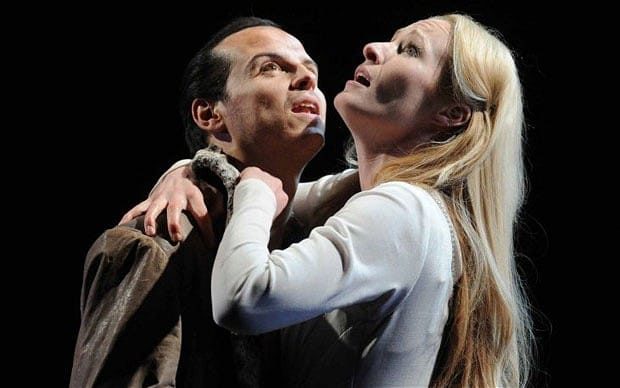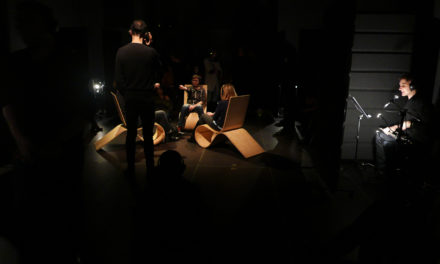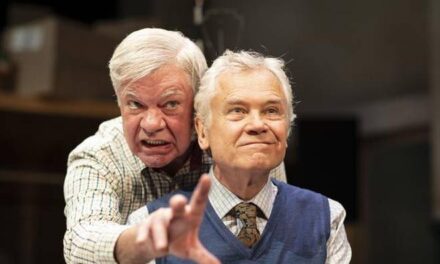Between 2002–2005, I carried the professional title of a Dramaturg in the UK. Even when confronted with the friendliest of dispositions, being a “dramaturg” in England [ii] inevitably goes hand in hand with having to explain what your job title means. Having continental roots (especially German, Scandinavian or Eastern European) appears to bestow more of a natural entitlement to the D-word; however, this by no means guarantees freedom of access to the English rehearsal room. My first projects in my new job was a devised piece that would consist of Romani music and folk-tales, which would form Northern Stage’s own contribution to an international festival the theatre would host in June 2003 called simply The Newcastle/Gateshead Gypsy Festival. One of my first tasks was to write brochure copy in which I would attempt to explain to our potential audience why this particular topic was relevant and timely. My response was to cite the increased mobility of the contemporary lifestyle as a form of cosmopolitan nomadism, which should bring us closer to understanding the “gypsy-condition:”
[W]e live in a time and place of mobile communications, information highways and space holidays. In the global village of multilingual families, we are all up-rooted. If the place of birth is anything to go by, most of us are displaced too. We are not Gypsies, but our condition is increasingly gypsy-like. And even if we cannot change the world, we can try to let the world change us. Hopefully for the better. [iii]
In Staging The UK, Jen Harvie identifies literariness as the most distinct feature of British theatre. She notes that this literary genealogy inevitably runs back to Shakespeare as the most prominent exponent of British theatre but also points out that the Lord Chamberlain’s office, active until 1968, inevitably required theatre to be script-based in order to facilitate censorship prior to a performance. [iv] She uses Aleks Sierz’s, Dan Rebellato’s, and Simon Shepherd’s recent British theatre histories to further substantiate this view and tease out several more particular characteristics–namely, anti-intellectualism and anti-theatricality:
By celebrating individual creativity, seeking isolation, indulging anti-theatricalism, and maintaining a hostility to theory, dominant British theatre culture resists collaborative practices, healthy miscegenation, and a recognition of creativity as labor, material practice, and intellectual practice. [v]
Luckhurst, too, recognizes that both British and American theatre features an underlying degree of anti-intellectualism, which she discerns for example in Terry McCabe’s attack on dramaturgs as “creatively bankrupt and destructive forces,” confined to not-for-profit theatres. [vi] Lyddiard’s decision, therefore, to appoint a dramaturg in conjunction with the University, in order to work with her on non-literary theatre, was unprecedented and unrepresentative of British theatre trends in every way.
Place
In their book Dramaturgy And Performance (2008), Cathy Turner and Synne Behrndt discuss a few very successful cases of dramaturgs emerging from or being absorbed organically into particular ensembles (e.g., Steven Canny with Complicite, Louise Mari with Shunt, David Williams with Lone Twin, Frauke Franz with Primitive Science/Fake Productions). Later on in 2005, when Alan Lyddiard resigned and I left Northern Stage in order to join the Learning Department at the RSC, my brief would be a bridge-building exercise between the RSC and the UK higher-education sector, through an initial link with the University of Warwick’s Centre for Excellence in Teaching and Learning, funded by Higher Education Funding Council for England (HEFCE). On the understanding that my main area of activity would be to bring a kinesthetic approach and the RSC’s rehearsal room methodology to the teaching of Shakespeare at the university level, I considered this particular work a form of dramaturgy too–but one that was oriented towards the audience rather than towards the production. As opposed to the work of the literary departments and the idea of “production dramaturgy” occurring in rehearsal rooms, I would call this kind of dramaturgical activity which includes the work of education departments, marketing departments, and theatre critics–”reception dramaturgy.” What particularly struck me about the way in which some of the RSC rehearsal rooms were arranged–especially in the first stages consisting of lengthy sessions sitting around the table and grappling with the text–was that the sheer number of people (the twenty-odd-member cast would initially be joined by an army of designers, voice coaches, movement directors, stage managers and technical crew) required everyone present to arrange themselves into two concentric circles. My practice as a dramaturg has by and large consisted of bridge-building, on the one hand, and on the other, a negotiation of frontiers between theory and practice, between writers and directors, between the show and the audience, between theatre and academia. Thinking about the place of a dramaturg in English theatre one, therefore, encounters “bridges” [vii] and “frontiers” [viii], not unlike those discussed by de Certeau [ix] the tackling of which eventually may even necessitate a kind of “delinquency:”
If the delinquent exists only by displacing itself, if its specific mark is not to live on the margins but in the interstices of the codes that it undoes and displaces, if it is characterized by the privilege of the tour over the state, then the story is delinquent. [x]
Interestingly, in a context like the UK one, those seen at the top of the theatres’ managerial pyramids are often Oxbridge graduates–and therefore not graduates in drama or theatre or performance studies. Although it is discernable how this might have led to the literariness of British theatre, one wonders how the trend of anti-intellectualism came about? Meanwhile, the literariness of British theatre would also, according to Conquergood’s standards, seem to imply a privilege of the textual over the embodied knowledge. This is the very “apartheid” his paper is trying to address by calling for an elevation of the experiential and participatory epistemologies to the level traditionally held by the textual and critical-intellectual ones.
Dramaturg
Turner’s and Behrndt’s 2008 book on dramaturgy, Dramaturgy And Performance, departs from an acknowledged position of the term’s own instability. Dramaturgy, they suggest, can be understood as composition, architecture, analysis, playwriting, research, producing, interpreting, critique, engagement with the context, and indeed the more precise and concise one tries to be, the more one invites the response: “Yes, but … ”’ [xi] Their study is both empirical and historical (devoting a considerable section to the Brechtian model as well as to the political dramaturgies of the UK). In a paper, Turner wrote on site-specific theatre in 2004. Inspired by de Certeau she proposed that “space could be viewed as ‘an aggregation of layered writings—a palimpsest.” [xii]
Conceptually, at least, Turner and Behrndt signal that the “millennial dramaturgies” as they call them, are marked by a whole set of new approaches to and variations on the theme of “narrative”–Lehmann’s “post-dramatic theatre,” Edward Soja’s “spatial turn,” Sarrazac’s “rhapsodic” dramaturgy, issues of liveness, presence, interactivity, intermediality, and new technologies. I am particularly intrigued by the account of Maike Bleeker’s “‘consideration of the interaction between stage and audience’ in terms of movement.” [xiii] Instead of emerging from the decoding of signs, meaning is no longer considered as static or fixed but in terms of how the performance ‘moves’ the audience. “The implication is that we might look for the politics of work in terms of what it does, rather than what it says.” [xiv] This, of course, is not a particularly new phenomenon in itself–even Shakespeare was aware of the theatre’s effect on the audience as he “moved” them through the plot using metatheatrical self-referencing–but it is a useful way of conceptualizing one of the potential functions of the dramaturg in a way that is less threatening to the rest of the creative team. The challenge is contained in the fact that the audience is by and large heterogeneous and will potentially follow a multitude of trajectories in response to any given mechanism–even if seated in a most conventional theatre space all the way through the performance. What the dramaturg can begin to monitor here are the vectors of movement, the force, the intention, the impact and the effect of the “movement” on the frontiers and boundaries of experience. Or more specifically, for example, as in the case of the Belgian company Ontroerend Goed’s production Internal—the most talked about show of the Edinburgh Fringe 2009—the dramaturg (Joeri Smet) might well be taking part, alongside four performers, in the show featuring probing and questioning of the audience and culminating in a one-to-one dance with a chosen audience member.
It seems that amid such a proliferation of potential functions for a dramaturg, the question is certainly not “what does the dramaturg do?” but “what is the dramaturg’s domain?”
In his consideration of spatial stories, de Certeau offers two modes of description: “the map”– the official organization of a series of “facts” about a particular space–and “the tour”–an account of a journey through the space. [xv] A dramaturg is neither solely the map (which I would say belongs to the director) nor the story (which may start with the writer but ultimately belongs to the actor)–but the journey itself (which is an experience and therefore immaterial, speculative, personal as well as potentially shared).
Anne Bogart raises the question of the dramaturg’s ownership within a context where everyone else has a clear domain, and suggests that this must apply to “archival materials and structural ideas,” while Anne Cattaneo seems to reinforce the same view by proposing that dramaturgs are “good at thinking structurally,” and “sensitive as to how something is shaped and how this shape or structure affects interpretation.” [xvi] I tend to agree and identify with this. During my time at Northern Stage, due to various international collaborations and research trips, I ended up traveling more than usual–to Hungary, Denmark, Russia, Spain, the United States. In addition to my various duties as part of my job description, I also regularly wrote travelogues for the internal newsletter. Often these journeys were related through the narratives that would be familiar to my readers, the travelogues reflected on patterns and leitmotifs that would be shaped to resonate with the particular works we were developing and were therefore intended to be of both professional and personal interest. But most interestingly, when I eventually moved on from Newcastle, my suitcases were full of “archival materials and structural ideas”–as well as a few maps and stories.
Returning to the “gypsy-condition,” which was the subject of one of my first dramaturgical assignments at Northern Stage, it is perhaps worth noting the following commonly held assumptions: unlike most other cultural minorities, Romanies tend to transcend or at least resist the question of cultural integration, as it is traditionally an inherent part of their culture to stay on the move. Although often seen as a delinquent element within the host culture, nevertheless Romanies have historically also generated their own appeal by embodying the values of freedom from societal constraints, deep passions and a spirit of adventure.
In conclusion to his chapter on spatial stories, de Certeau proposes that…in matters concerning space, [the] delinquency begins with the inscription of the body in the order’s text. The opacity of the body in movement, gesticulating, walking, taking its pleasure, is what indefinitely organizes a here in relation to an abroad, a “familiarity” in relation to a “foreignness.” [xvii]
In short, he reiterates his departure point that “space is a practiced place.” [xviii] This paper could be seen to result from an implicit understanding that there is no pre-existing defined space for a dramaturg in an English rehearsal room. It is particularly worth acknowledging here that those old hierarchies between the text and performance themselves appear to be on the move and subject to change, [xix] thus requiring a new way of engagement between the meaning being created and the audience response. It seems therefore that the best “tactic” for a dramaturg in dealing with the “strategies” of the English theatre and performance context (whatever that may mean in the climate of globalization) is simply to continue practicing his or her craft, wherever he or she happens to be, and under whatever name seems suitable.
The original version of this article, was published in The Routledge Companion to Dramaturgy. Reposted with permission.
Footnotes:
I. The full version of this article originally appeared: Radosavljević, Duška. The Need To Keep Moving: Remarks On The Place Of A Dramaturg In 21st Century England, Performance Research: On Dramaturgy 14, 3 (Taylor and Francis, 2015), 45-51.
ii. I speak of ‘England’ because England has been the main site of my practice. I am quite aware that the word ‘dramaturg’ tends to have a bit more currency in Scottish and Northern Irish theatre, for example, while I am not fully acquainted with the status of a dramaturg in Wales.
iii. Radosavljević, Duška, ‘Programme Note’, Spring Brochure (Northern Stage, 2003).
iv. Harvie, Jen, Staging the UK (Manchester and New York: Manchester University Press, 2005), 116.
v. Ibid., 119.
vi. Luckhurst, Mary, Dramaturgy: A revolution in theatre (Cambridge: Cambridge University Press, 2006) 211.
vii. “The bridge is ambiguous everywhere: it alternately welds together and opposes insularities. It distinguishes them and threatens them. It liberates from enclosure and destroys autonomy … Justifiably, the bridge is the index of the diabolic in the paintings where Bosch invents his modifications of spaces.” Certeau, Michel de, The Practice of Everyday Life (Berkeley: University of California Press, 1984), 128.
viii. “The theoretical and practical problem of the frontier: to whom does it belong? The river, wall or tree makes a frontier. It does not have a character of a nowhere that cartographical representation ultimately presupposes. It has a mediating role,” (Ibid., 127).
ix. Ibid., 126-9.
x. Ibid., 130.
xi. Turner, Cathy and Behrndt, Synne, Dramaturgy and Performance (Basingstoke: Palgrave MacMillan, 2008), 17.
xii. Turner, Cathy, “Palimpsest or Potential Space? Finding a vocabulary for site-specific performance,” NTQ 20(4) (November, 2004): 373-90.
xiii. Ibid., 92.
xiv. Ibid., 93.
xvi. Turner, Cathy and Behrndt, Synne, 2008,164.
xvii. Certeau, 130.
xviii. Ibid., 119
xix. In re-examining the changing relationship between the text and performance and the strategies for their creation, Patrice Pavis also concludes that this new trend “encourages us to go forward, to move our feet and not get stuck in the same position forever.”. Pavis, Patrice “On Faithfulness: The difficulties experienced by the text/performance couple,” Theatre Research International, International Federation for Theatre Research, 33(2) (2008): 117-26
This post was written by the author in their personal capacity.The opinions expressed in this article are the author’s own and do not reflect the view of The Theatre Times, their staff or collaborators.
This post was written by Duška Radosavljević.
The views expressed here belong to the author and do not necessarily reflect our views and opinions.


















